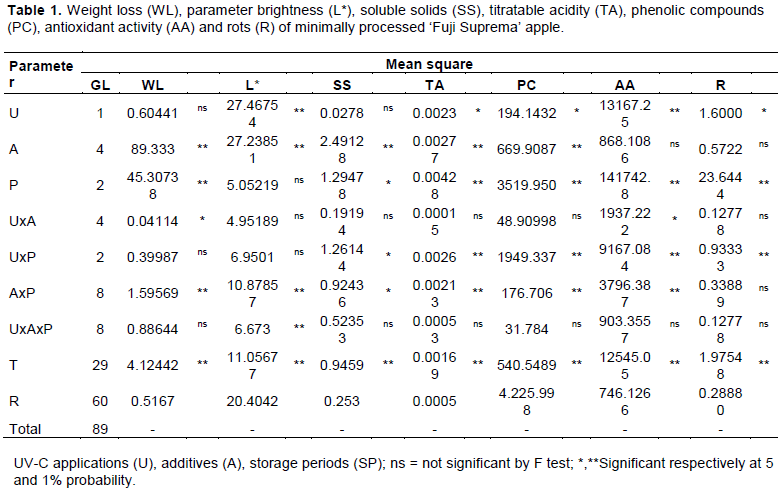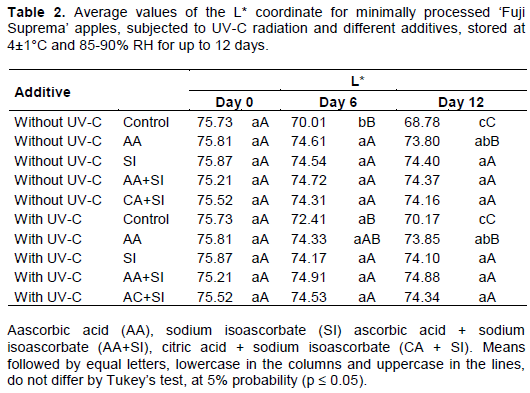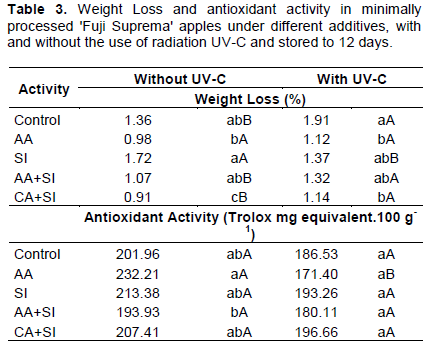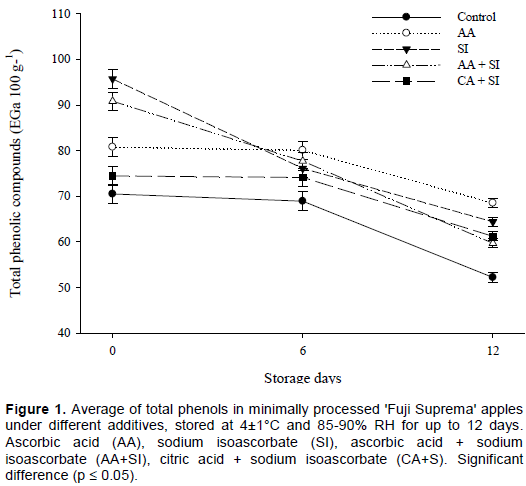ABSTRACT
Minimally processed fruits need to be treated with techniques to keep their quality, and lower the incidence of their pulp and rots becoming black. In this context, this work aims to evaluate the efficiency of the use of UV-C radiation and different additives in preventing browning and conserving ‘Fuji Suprema’ apples that are minimally processed. The experimental design was completely randomized with factorial scheme of 5x2x3 (5 additives x 2 UV-C applications x 3 storage periods). The apple slices were placed in solutions containing the following: control; ascorbic acid (1%); sodium isoascorbate (1%); ascorbic acid (0.5%) + sodium isoascorbate (0.5%); citric acid (0.5%) + sodium isoascorbate + 0.5%. It was used with and without UV-C radiation in minimally processed apples, the intensity of the radiation emitted was 2.71 kJ.m-². Then the trays were stored in a cold room at 4±1°C temperature and a relative humidity of 85-90%. They were stored for periods of 0, 6 and 12 days. The parameters assessed were: mass loss, pulp color, soluble solids, titratable acidity, rot incidence, total phenolic compounds and antioxidant activity. The use of ascorbic acid, sodium isoascorbate and associate compounds contributes to the keep of the pulp color of the minimally processed apples on 12th day of storage. UV-C reduces rot incidence, and increases the soluble solids, phenolic compounds and antioxidant activity, when compared without the use of UV-C radiation on 12th day of storage. The ascorbic acids keep the total phenolic concentration in the minimally processed apples.
Key words: Malus domestica, storage duration, phytochemical content.
The minimally processed fruits sector is expanding due to changes in the patterns of fruits consumption, consumers’ want, ease of preparation and consumption. However, minimally processed fruits preparation requires the use of techniques which are able to keep their quality with low incidence of both pulp browning and rot. In this context, minimum processing is a way of using surplus production and adding value to the product (Villas-Boas et al., 2009), besides meeting the new demands of the consumer market.
Some steps are involved in minimal processing: sanitization, peeling and cutting, ease of consumption (Perera et al., 2010), and reduction of post-harvest life. Minimal processing operations not only cause mechanical damage to fruit tissues but also accelerate senescence and deterioration, thus, leading to discoloration and loss of nutritional value (Kluge et al., 2014), fast pulp browning (Perera et al., 2010), texture loss and microbial growth (Fontes et al., 2008), besides changes in physico-chemical characteristics and variation in the contents of specialized metabolism compounds. Therefore, some of the major challenges of minimal processing are to enhance the shelf life and preserve the quality of fruits.
Minimally processed apples are highly perishable products as a result of the acceleration of the respiratory metabolism and maturation stage. Injuries caused in plant tissues, as a result of manipulation processing which promotes increased contact between the enzymes and substrates, induce undesired enzymatic reactions (Fontes et al., 2008) and cause pulp browning. Fast browning happens due to the production of melanin which results from reactions catalyzed by enzymes, such as peroxidase and polyphenol oxidase (Tomás-Barberán and Spín, 2001).
Therefore, new preservation techniques must be developed in order to keep the quality of minimally processed foods so as to increase their useful life. Antioxidant compounds, such as ascorbic acid, citric acid (Kluge et al., 2014) and sodium isoascorbate (Martins et al., 2011). Associated with these techniques, UV-C radiation can be used in minimally processed products, which have germicidal effect and lowers rot incidence. The application of UV-C in minimally processed apples has been tested (Gómez et al., 2010; Chen et al., 2016). However, the reported effects are quite diverse, depending on the cultivar and applied doses.
In this context, it proposed to assess the effectiveness of the use of UV-C light and different additives in preventing browning and conserving minimally processed apples ‘Fuji Suprema’.
The apple cultivar used by this study was ‘Fuji Suprema’. The fruits were grown in a commercial orchard, about 15 km from São Joaquim, a city located around 1350 m above sea level in Santa Catarina state, Brazil (28°17’38’’ S and 49°55’54’’ W) and harvested in the season 2014/1015.
The fruits were pre-selected based on the following criteria: absence of injuries and visual disease incidence. After fruits selection, these were sanitized with sodium hypochlorite at 200 mg.L-¹ for 10 min at room temperature. The selected apples were cut into six gore format slices, with the help of sanitized stainless steel knives.
The experimental design was completely randomized with factorial scheme of 5x2x3 (5 additives x 2 UV-C applications x 3 storage periods), with 4 repetitions consisting of 9 slices of minimally processed apples. The apple slices were dipped for 2 minin solutions containing the following treatments: control (distilled water); ascorbic acid (AA), 1% (w/v); sodium isoascorbate (SI), 1% (w/v); ascorbic acid, 0.5% (w/v) + sodium isoascorbate, 0.5% (w/v); citric acid (CA), 0.5% (w/v) + sodium isoascorbate + 0.5% (w/v). Then the pieces were drained for 2 to 3 min in order to remove the excess of solution and then slices were dried in a refrigerated environment (10±1°C) for 15 min.
Apple pieces were placed on 300x230x33 milimeter expanded polystyrene trays and wrapped in 9 µ stretchable PVC film. The mean weight of every tray was 250 g. UV-C Phillips® 30 W was used in minimally processed apples. The distance between the lamps and trays were approximately 50 cm and the intensity of the radiation emitted by the lamps was measured with a digital UV light meter (RS-232 MRUR-203 Model, Instrutherm). It results in an intensity of 2.71 kJ.m-² per two minutes application. Then the trays were stored in a cold room at 4±1°C temperature, with a relative humidity of 85-90%, and stored for periods of 6 and 12 days.
The parameters assessed were: a) mass loss: obtained by the difference between the total mass before and after the storage, data expressed in percentage of total mass (%); b) pulp color, measured with colorimeter Minolta CR-300® brand, with tridimensional color system (CIE L a b). The results were expressed by L, which represents color lightness (0 = black and 100 = white), by the a* value, which is ranged from green (−a) to red (+a), by the b*-value axis, which is ranged from blue (−b) to yellow (+b), and hue angle and hue; c) soluble solids (SS): obtained by refractometry, results expressed in °Brix; d) titratable acidity: determined by titration of a solution that contained 10 mL of juice diluted in 100 mL of distillated water, with a solution of NaOH 0.1 N, results expressed in percentage of malic acid; e) the rot incidence was considered in the fruits with lesions with diameter greater than 0.1 cm, the results were expressed as percent (%); f) total phenolic compounds, determined by the method based on reaction with the Folin-Ciocalteau reagent according to the adapted method of Singleton et al. (1999), with the results expressed in mg equivalent of gallic acid in 100 g sample (EGA 100 g-1); g) antioxidant activity, determined by DPPH radical method adapted from Brand-Williams et al. (1995), with the results expressed in Trolox mg equivalent.100 g-1 of fruits.
The analysis of variance (ANOVA) was performed for all the parameters evaluated. Significant parameters averages were compared through Tukey’s test (p < 0.05).
Through the data in Table 1, it is observed that the variables weight loss and antioxidant activity had significant effects with the different additives and UV-C applications. The storage periods x UV-C applications showed significant interaction for the variable parameter soluble solids, titratable acidity, phenolic compounds, antioxidant activity and rot. The additives and storage periods showed significant interaction for the entire variable. In fruits coloring, the L* parameter (brightness) represents lighter fruits (highest L*value) or darker fruits (lower L*). For this parameter, there was interaction between additives, application of UV-C and periods of cold storage factors in minimally processed 'Fuji Suprema' apples.

Additives associated with UV-C radiation showed promising results in maintaining the color in both storage times, keeping the apples lighter in the control without and with UV-C (Table 2). The treatments with additives were more effective in preventing the surface browning of apples. The brightness results corroborate with Perez-Gago et al. (2006), who also found in 'Golden Delicious' apples the inhibitory effect of enzymatic browning by the use of antioxidants, after storage for 14 days at 5°C.

On the other hand, the control without additives showed lower L* values, a fact that implied pulp browning. There was more intense pulp browning in the control without UV-C after the 6th storage day whereas it happened after the 12th day in the control treatment with UV-C. These results agree with the ones reported by Fontes et al. (2008), whose study showed that the control treatment in minimally processed apples had high browning index. Pulp browning is one of the main problems related to minimally processed products since it affects the color of the surface of the fruit, which is an important quality attribute to the commercialization of the product (Jang and Moon, 2011).
In the control treatment, mass loss increased in the minimally processed apples with UV-C radiation, by comparison with apples with no UV-C radiation (Table 3). Minimally processed apples without application of UV-C radiation had less mass loss in CA+SI, whereas it happened with AA and CA+SI when UV-C radiation was applied. The use of UV-C associated with citric acid contributed to reduce weight loss in minimally processed apples during storage (Chen et al., 2016). UV-C radiation may develop a protective film on minimally processed fruits. However, long exposure to U-VC radiation may break cell membranes of apples and favor fruit dehydration and increase in mass loss (Chen et al., 2016). Rupture of cell membranes may also increase the contact between enzymes and substrate, thus, favoring browning (Gómez et al., 2010).

Ascorbic acid (AA), sodium isoascorbate (SI), ascorbic acid + sodium isoascorbate (AA+SI), citric acid + sodium isoascorbate (CA+S).Means followed by equal letters, lowercase in the columns and uppercase in the lines, do not differ by Tukey’s test, at 5% probability (p ≤ 0.05).
Without the application of UV-C radiation in minimally processed apples, the highest concentrations of antioxidant activity were observed in AA, control, SI, CA+SI. However, when applied UV-C radiation in minimally processed there were no differences between the additives. Application of UV-C enhanced of antioxidant activity in fresh-cut mangoes (González-Aguilar et al., 2007) and UV-C radiation with heat in broccoli (Lemoine et al., 2010).
The application of UV-C in minimally processed apples interfered in the rot percentage, soluble solids, phenolics concentration and antioxidant activity during cold storage periods (Table 4). On the 12th day of storage the use of UV-C reduced the rot percentage in minimally processed apples. Use of radiation alone or in combination with other techniques optimizes the conservation of minimally processed apples. Radiation resulted in an efficient control of microbial contamination in other fruits, such as minimally processed mango (Vieites et al., 2004) and melon (Manzocco et al., 2011).
The soluble solids from the minimally processed apples showed higher values with the application of UV-C on the 12th day of cold storage. However, the rise of the sugar concentration of the fruit occurs occurs with the evolution of fruit maturation (Jie et al., 2013).
The total phenolics concentration in minimally processed apples was higher with the use of UV-C at 6th and 12th day. The increase of the phenolic compounds is a way of protecting cells from UV-C radiation (De Wit, 2007; Erkan et al., 2008), as an adaptation response to stress (Keutgen et al., 2011).
Antioxidant activity was higher on the 12th day of refrigerated storage for treatment with UV-C radiation when compared to the treatment without radiation. The use of UV-C increased the content of phenolic compounds and antioxidant activity in strawberry, because the UV-C radiation may cause different types of stress and activate defense responses in fruits (Erkan et al., 2008).
There was interaction between additives and storage periods for the total phenolic concentration in minimally processed apples (Figure 1). Decrease in total phenol contents in minimally processed apples during the cooled storage period as a result of the metabolism of fruit maturation and senescence was observed. It led to the oxidation of these compounds by polyphenol oxidases (Mishra et al., 2012). On the 12th day, the reduction of phenols content was higher in the control apples, in relation to other additives. The use of AA kept the total phenolic content in minimally processed apples on the 12th day. The preservation of the total phenolic compounds by the AA, probably occurs because this acid can sequester free oxygen and prevent oxidation action of polyphenoloxidase (Rico et al., 2007).

The additives affected the weight loss, titratable acidity, soluble solids and antioxidant activity of minimally processed apples in relation to cold storage periods (Table 5). There was increase in the mass loss during cold storage period in all treatments. There was no statistical difference in weight loss on the 6th day; however, on day 12th weight loss was higher in the control apples. Mass loss in the control treatment was also higher in minimally processed ‘Royal Gala’ apples, reaching 8.78% after a 15 day cooled storage period (Pizato et al., 2013).

There was no difference in total acidity among the additives on the day the experiment was installed (day 0). Titratable acidity was high in minimally processed apples treated with SI on the 12th day. In this study, variations in mean values of titratable acidity in the storage period ranged from 0.27 to 0.30% malic acid on the day the experiment was installed (Day 0), from 0.25 to 0.26% on the 6th day and from 0.22 to 0.25% on the 12th day, among the treatments under study. Titratable acidity of minimally processed apples treated with edible films ranged from 0.26 to 0.56% malic acid (Fontes et al., 2008).
On the 12th day of cold storage, the control and AA increased the concentration of soluble solids in minimally processed apples. Pizato et al. (2013) observed that the control treatment got a high increase in soluble solids in minimally processed apples with edible coatings in a 15 day storage period. Increase in soluble solids observed in the storage period, regardless of the use of additives in minimally processed apples, may be related to sugar accumulation due to humidity loss.
Additives used by this study affected antioxidant activity of apples; the treatments with AA and AA + IS led to the highest concentrations on the 6th day of cold storage; while on the 12th day, they were AA, SI, AA+SI and CA+SI. However, the control showed had the lowest antioxidant capacity and did not differ statistically from AA, SI and CA+SI ot the 12th day of cold storage. Oms- Oliu et al. (2008) achieved high levels of antioxidant activity and the maintenance of this compound in pears minimally processed and coated with polysaccharides.
The use of ascorbic acid, sodium isoascorbate and associates contributes to keep the color of minimally processed ‘Fuji Suprema’ apples under refrigeration, for up to twelve days. The use of UV-C in minimally processed apples mitigated the incidence of rot and increased their contents of soluble solids and total phenols, besides their antioxidant activity on the 12th day of storage. Ascorbic acid contributed to the total phenol content in minimally processed apples on the 12th day.
The authors have not declared any conflict of interests.
REFERENCES
|
Brand-Williams W, Cuvelier ME, Berset, C (1995). Use of a free radical method to evaluate antioxidant activity. Food Sci. Technol. 28(1): 25-30.
Crossref
|
|
|
|
Chen C, Hu W, He Y, Jiang A, Zhang R (2016). Effect of citric acid combined with UV-C on the quality of fresh-cut apples. Postharvest Biol Technol. 111:126-131.
Crossref
|
|
|
|
|
De Wit PJ (2007). How plants recognize pathogens and defend themselves. Cell Mol Life Sci. 64(21):2726-2732.
Crossref
|
|
|
|
|
Erkan M, Wang SY, Wang CY (2008). Effect of UV treatment on antioxidant capacity, antioxidant enzyme and decay in strawberries fruit. Postharvest Biol. Tech. 48:163-171.
Crossref
|
|
|
|
|
Fontes LCB, Sarmento SBSS, Spoto MHF, Dias CTS (2008). Preservation of minimally processed apple using edible coatings. Food Sci. Technol. 28(4):872-880.
Crossref
|
|
|
|
|
Gómez PL, Alzamora SM, Castro MA, Salyatori (2010). Effect of ultraviolet-C light dose on quality of cut-apple: Microorganism, color and compression behavior. J Food Eng. 98(1):60-70.
Crossref
|
|
|
|
|
González-Aguilar GA, Zavaleta-Gatica R., Tiznado-Hernández ME (2007). Improving postharvest quality of mango 'Haden' by UV-C treatment. Postharvest Biol. Technol. 45(1):108-116.
Crossref
|
|
|
|
|
Jang JH, Moon KD (2011). Inhibition of polyphenol oxidase and peroxidase activities on fresh-cut apple by simultaneous treatment of ultrasound and ascorbic acid. Food Chem. 124(2):444-449.
Crossref
|
|
|
|
|
Jie D, Xie L, Fu X, Rao X, Ying Y (2013). Variable selection for partial least squares analysis of soluble solids content in watermelon using near-infrared diffuse transmission technique. J. Food Process Eng. 118(4):87-392.
Crossref
|
|
|
|
|
Keutgen AJ, Pawelzik E (2007). Modifications of Strawberry fruit antioxidant pools and fruit quality under NaCl stress. J. Agric. Food Chem. 55(10):4066-4072.
Crossref
|
|
|
|
|
Kluge RA, Geerdink GM, Tezotto-Uliana JV, Guassi SAD, Zorzetto TQ, Sasaki FFC, Mello SC (2014). Quality of minimally processed yellow bell pepper treated with antioxidants, Semin. Cienc. Agrar. 35(2):801-812.
Crossref
|
|
|
|
|
Lemoine ML, Chaves AR, Martínez GA (2010). Influence of combined hot air and UV-C treatment on the antioxidant system of minimally processed broccoli (Brassica oleracea L. var. Italica). LWT Food Sci. Technol. 43(9):1313-1319.
Crossref
|
|
|
|
|
Martins RN, Mattiuz B, Santos LO, Morgado CMA, Mattiuz CFM (2011). Preservation of minimally processed 'Aurora-1' peaches using additives. Rev. Bras. Frutic. 33(4):1229-1239.
Crossref
|
|
|
|
|
Manzocco L, De Pieve S, Maifreni M (2011). Impact of UV-C light on safety and quality of fresh-cut melon. Innov. Food Sci. Emerg. Technol. 12(1):13-17.
Crossref
|
|
|
|
|
Mishra BB, Gautam S, Sharma A (2012). Browning of fresh-cut eggplant: Impact of cutting and storage. Postharvest Biol. Technol. 67:44-51.
Crossref
|
|
|
|
|
Oms-Oliu G, Soliva-Fortuny R, Martín-Belloso O (2008). Edible coatings with antibrowning agents to maintan sensory quality and antioxidant properties of fresh-cut pears. Postharvest Biol. Technol. 50(1):87-94.
Crossref
|
|
|
|
|
Perera N, Gamage TV, Wakeling L, Gamlath GGS, Versteeg C (2010). Color and texture of apples high pressure processed in Pineapple juice. Innov. Food Sci. Emerg. Technol. 11(1):39-46.
Crossref
|
|
|
|
|
Perez-Gago MB, Serra M, Del-río M (2006). Color changes of fresh-cut apples coated with why protein concentrate-based edible coatings. Postharvest Biol. Technol. 39(1):84-92.
Crossref
|
|
|
|
|
Pizato S, Cortez-Veja WR, Prentice-Hernández C, Borges CD (2013). Effect of applying different edible coatings on conservation of minimally processed 'Royal Gala' apples. Semin. Cienc. Agrar. 34(1):253-264.
Crossref
|
|
|
|
|
Rico D, Martin-Diana AB, Barat JM, Barry-Ryan C (2007). Extending and measuring the quality of fresh-cut fruit and vegetables: A review. Trends Food Sci. Technol. 18(7):373-386.
Crossref
|
|
|
|
|
Singleton VL, Orthofer R, Lamuela-Raventós RM (1999). Analysis of total phenols and other oxidation substrates and antioxidants by means of folin-ciocalteu reagent. Methods Enzymol. 299(4):152-178.
Crossref
|
|
|
|
|
Tomás-Barberán FA, Espín JC (2001). Phenolic compounds and related enzymes as determinants of quality in fruits and vegetables. J. Sci. Food Agric. 81(9):853-879.
Crossref
|
|
|
|
|
Vieites RL, Evangelista EM, Campos AJ, Moreira GC (2004). Effect of the packing and the gama irradiation on the microbiological contamination control of the minimally processed mango. Semin. Cienc. Agrar. 25(3):197-206.
Crossref
|
|
|
|
|
Villas Boas EVB, Reis CMF, Melo AA, Martins B (2009). Use of chemical mixtures for firmness maintenance of fresh-cut 'Silver' banana. Ciênc. Agrotec. 33(1):237-244.
|
|